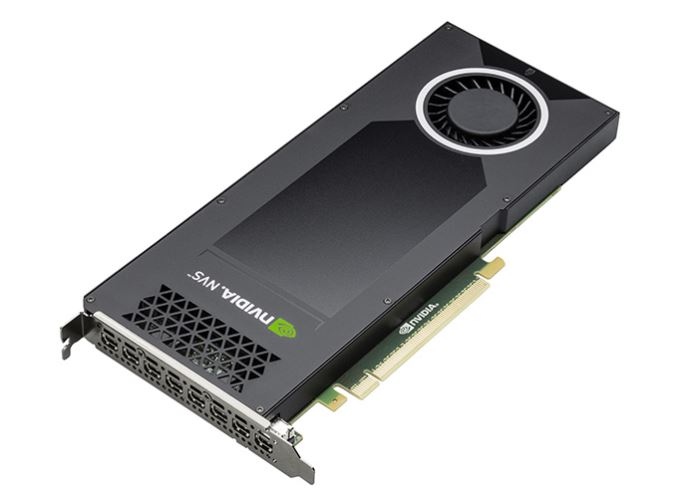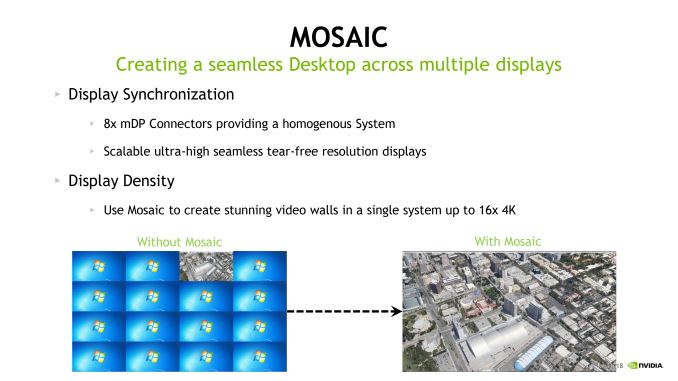NVIDIA Launches NVS 810 Digital Signage Video Card
by Daniel Williams on November 4, 2015 5:30 PM EST
Entry level multi-display workstations aren’t a market that gets anywhere near the amount of attention that many of us are used to seeing in other markets. Never the less it is a market that definitely needs something catering to its needs, be it large format signage, financial trading, or any other area where a large number of displays are needed but not a large amount of horsepower to push them.
To that end, today NVIDIA is launching a new entry into their venerable NVS multi-display lineup, the NVS 810. Seeing as this market segment doesn't see updates very often this is the first and possibly only Maxwell based card to be released in this sector. This card is based around a pair of GM107 GPUs on a single board, allowing NVIDIA to outfit the NVS 810 with 8 mini-DP 1.2 ports on a single-wide PCIe card.
For the NVS 810’s hardware, under the hood we are looking at a pair of partially enabled GM107 GPUs with 512 of 640 CUDA cores enabled, for a total of 1024 CUDA cores. This is paired up with 2GB of VRAM per GPU for a total of 4GB, and though NVIDIA doesn’t specify the memory type it’s safe to assume it’s DDR3. Otherwise NVIDIA is targeting a relatively low power profile here – just 68W total board power – with the lower board power helping with GPU density and makes stuffing the maximum of four of these cards into a single machine at once a much more civil affair.
| NVIDIA NVS 810 Specfications | ||
| NVS 810 | ||
| CUDA Cores | 2 x 512 (1024) | |
| Memory | 2 x 2GB (4GB) | |
| Display Connectors | 8x Mini DisplayPort (8x 4096x2160 @ 30Hz or 4x 4096x2160 @ 60Hz) |
|
| Max Configuration (Win10/Linux) |
4 Boards, 32 Displays | |
| Total Board Power | 68W | |
| Length | 9.5" | |
| Width | Single Wide (4.4") | |
| Cooling | Active | |
| MSRP | $650-$750 | |
Speaking of stuffing cards in a machine, while I imagine that real world implementations of this may be rare, where I notice that this solution gets immensely crazy is the sheer number of mDP ports on hand coupled with the ability to fit four in one machine. Coupled with NVIDIA’s Mosaic display stitching and synchronization software, it’s possible to use a pair of NVS 810s together to drive up to 16 4K displays as if they are one massive display. Regardless of the rarity of such an implementation the idea that one could build a micro-ATX computer that could drive what’s functionally a 137MP display is a very impressive thought indeed.
Wrapping things up, NVIDIA tells us that the NVS 810 is expected to have a street price in the $650-$750 range. Overall the company is pitching the NVS 810 as a high density, low total cost solution to situations requiring a large number of high pixel count displays. As a result NVIDIA is chasing a very specific market with the board, but for those with such needs the NVS 810 brings quite a bit to the table.











38 Comments
View All Comments
Morawka - Thursday, November 5, 2015 - link
who says it has to be a firepro, radeons support tiled displaysAntDX316 - Thursday, November 12, 2015 - link
It's designed for scientific applications. Look it up on youtube.3ogdy - Thursday, November 5, 2015 - link
This does make sense and definitely has its usage scenarios. I immediately thought of the unbelievable amount of displays used as (video) background in TV shows. Those guys use many screens put together to output a single image across all of them. That's where some horsepower and cards like this nVidia would make sense. Of course, it would also be within a (news) TV channel's budget. Given Adobe's products are amazing (AE and Premiere) and TV channels do use them to create impressive visuals, no wonder this would be better than the AMD alternative. RayTracing isn't supported on AMD cards, unfortunately and rendering barely makes use of AMD GPUs, most of the time it's the CPU that's doing the hard work , including Ray Tracing.MrSpadge - Thursday, November 5, 2015 - link
That's a pretty poor ray tracing implementation. With Open CL 2.0 support on AMD GPUs this should only be a matter of sitting down and writing the proper code. Well, an paying the developer(s) to do so.romrunning - Thursday, November 5, 2015 - link
What kind of displays are used in video walls? I would love to know if consumer TVs can be used, or if these are special models. I would think they would need to be a special "borderless" model, but maybe not - I don't really know. Maybe at the range from which they are viewed, the borders "fade" into the image.Mikemk - Thursday, November 5, 2015 - link
Any TV or monitor works, but NVIDIA's drivers requires they all be the same model.danstar7 - Thursday, November 5, 2015 - link
NEC makes displays for video walls that are "borderless" Any TV with the proper video input would work though.HammerStrike - Friday, November 6, 2015 - link
While any display will theoretically "work", the question is for how long and how well. Samsung, LG, NEC, Planar (others, etc) all make commercial panels designed specifically for video walls. This includes:- super narrow bezels (as low as 2mm screen-to-screen - with LCD based displays there is no true "borderless" designs - used to have that with some DLP based displays years ago, but those are long gone)
- uniform chassis design so all the screens in the array "fit" together properly (many consumer sets have slight curvature to their chassis - not noticeable individually, but try placing them in an array and you have issues)
- built in scalers that automatically take a 1080p input and scale it across the array, as long as you have a symmetrical arrangement (2x2, 3x3, etc) - no need for an external controller, just a 1080p source.
- advanced color calibration features to ensure uniform color tracking across the array, as well as a larger color gamut for color critical operations (a lot of high end video walls are marque installs, and the company logo, etc needs to be spot on).
- cooling and airflow designed to operate when the screens are stacked on each other - seems minor until you start losing units from overheating
- advanced control through RS-232 and/or TCP/IP
- advanced vendor warranty and technical support
- Some models have built in media controllers for custom or "HiDPI" implementations (i.e. 1x4, 2x2x6, etc configurations, or driving the entire array at its native resolution - i.e. a 4x4 array of 1080p panels has a native resolution of 33MP)
- longer production cycles and, when model lines are refreshed, backwards compatibility - quickest way to ruin the look of a video wall is trying to replace a failed screen a year or two into the install and the original panels are no longer available, with no replacement.
2old4this - Thursday, November 5, 2015 - link
My 5p:- Nvidia/PNY have a line up for this market segment: NVS (300, 500 and now 800).
- These cards are rather dumb. More 2D than 3D. Not intended for games.
- More for workstations and OEMs that need to drive a set of displays.
- The market of Signage is substantial. Think of public displays in airports, stations, malls, shops.
- The article misses the display port 1.2 streaming functionality that allows 1 card to drive up to 32 displays.
ZeDestructor - Thursday, November 5, 2015 - link
To counter/comment on your 5p:1. They have for a looooong time now, though Matrox was way aherad of them back in the day.
2. Yup. For simple video rendering, you don't need all that much more - this isn't a gaming or even 3D workstation card at all.
3. Yup. Also think about stuff like large financial displays, all of which lead back to point 2 of being very 2D-focused.
4. Yup.
5. Bandwidth limitations come into play - you can either MST 4 1080p, or 1 4K. For multiple 4K, you need more ports.